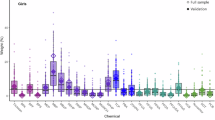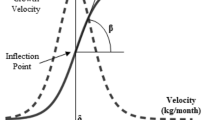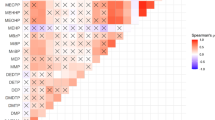Abstract
Background
Limited data exist regarding child neurodevelopment in relation to maternal occupational exposure to endocrine-disrupting chemicals (EDCs).
Methods
We included 1058 mother–child pairs from the INfancia y Medio Ambiente (INMA) project (2003–2008). Using a job-exposure matrix, exposure probability scores for ten EDC groups were assigned to each mother based on her longest held job during pregnancy. At the child’s 5-year visit, the McCarthy Scales of Children’s Abilities was administered, yielding the general cognitive index and scales for specific cognitive domains. We analyzed region-specific associations between EDC exposures and each outcome separately using adjusted linear regression and combined region-specific effect estimates using random-effects meta-analyses.
Results
Approximately 24% of women were exposed to at least one EDC group, but exposure to most individual EDC groups was low (<5%). Maternal organic solvent exposure was associated with lower quantitative scores among children (−5.8 points, 95% confidence interval: −11.0, −0.5). Though statistically non-significant, exposures to polycyclic aromatic hydrocarbons, phthalates, alkylphenolic compounds, and miscellaneous chemicals were associated with poorer offspring performance for most or all cognitive domains.
Conclusions
This study found limited evidence for a role of maternal occupational EDC exposures on child cognition. Further research is needed to better characterize exposures among pregnant workers.
Impact
-
Using data from a prospective birth cohort, we help fill an important research gap regarding the potential consequences of work-related exposure to endocrine-disrupting chemicals (EDCs) among pregnant women on child neurodevelopment.
-
We expand on existing literature—largely limited to pesticide and organic solvent exposures—by using a job-exposure matrix to estimate exposure to several EDC groups.
-
We found limited evidence of an association between maternal occupational EDC exposure and children’s overall cognition.
-
We did observe specific associations between exposure to organic solvents and lower quantitative reasoning scores.
Similar content being viewed by others
Log in or create a free account to read this content
Gain free access to this article, as well as selected content from this journal and more on nature.com
or
Data availability
Data are owned by the INMA Project and are available upon reasonable request by contacting inma@proyectoinma.org. Information regarding the INMA Collaboration Policy is available here: https://www.proyectoinma.org/en/inma-project/inma-collaboration-policy/.
Change history
22 September 2022
A Correction to this paper has been published: https://doi.org/10.1038/s41390-022-02300-8
References
Gore, A. C. et al. EDC-2: The Endocrine Society’s Second Scientific Statement on Endocrine-Disrupting Chemicals. Endocr. Rev. 36, E1–E150 (2015).
Grandjean, P. & Landrigan, P. J. Neurobehavioural effects of developmental toxicity. Lancet Neurol. 13, 330–338 (2014).
Rice, D. & Barone, S. Critical periods of vulnerability for the developing nervous system: evidence from humans and animal models. Environ. Health Perspect. 108(Suppl 3), 511–533 (2000).
Eurostat. Employment rate by sex. https://ec.europa.eu/eurostat/web/products-datasets/-/tesem010 (2020).
Hines, C. J. et al. Urinary phthalate metabolite concentrations among workers in selected industries: a pilot biomonitoring study. Ann. Work Expo. Health 53, 1–17 (2008).
Brouwers, M. M., van Tongeren, M., Hirst, A. A., Bretveld, R. W. & Roeleveld, N. Occupational exposure to potential endocrine disruptors: further development of a job exposure matrix. Occup. Environ. Med. 66, 607–614 (2009).
Nesan, D. & Kurrasch, D. M. Gestational exposure to common endocrine disrupting chemicals and their impact on neurodevelopment and behavior. Annu. Rev. Physiol. https://doi.org/10.1146/annurev-physiol-021119-034555 (2019).
Sanders, A. P., Claus Henn, B. & Wright, R. O. Perinatal and childhood exposure to cadmium, manganese, and metal mixtures and effects on cognition and behavior: a review of recent literature. Curr. Environ. Health Rep. 2, 284–294 (2015).
Radke, E. G., Braun, J. M., Nachman, R. M. & Cooper, G. S. Phthalate exposure and neurodevelopment: a systematic review and meta-analysis of human epidemiological evidence. Environ. Int. 137, 105408 (2020).
Perera, F. P. et al. Prenatal airborne polycyclic aromatic hydrocarbon exposure and child IQ at age 5 years. Pediatrics 124, e195–e202 (2009).
Gonzalez-Alzaga, B. et al. A systematic review of neurodevelopmental effects of prenatal and postnatal organophosphate pesticide exposure. Toxicol. Lett. 230, 104–121 (2014).
Julvez, J. & Grandjean, P. Neurodevelopmental toxicity risks due to occupational exposure to industrial chemicals during pregnancy. Ind. Health 47, 459–468 (2009).
Zhu, J. L., Vestergaard, M., Hjollund, N. H. & Olsen, J. Pregnancy outcomes among female hairdressers who participated in the Danish National Birth Cohort. Scand. J. Work Environ. Health 32, 61–66 (2006).
Andersen, H. R., Debes, F., Wohlfahrt-Veje, C., Murata, K. & Grandjean, P. Occupational pesticide exposure in early pregnancy associated with sex-specific neurobehavioral deficits in the children at school age. Neurotoxicol. Teratol. 47, 1–9 (2015).
Marks, A. R. et al. Organophosphate pesticide exposure and attention in young Mexican-American children: the CHAMACOS study. Environ. Health Perspect. 118, 1768–1774 (2010).
Bouchard, M. F. et al. Prenatal exposure to organophosphate pesticides and IQ in 7-year-old children. Environ. Health Perspect. 119, 1189 (2011).
Vrijheid, M., Armstrong, B., Dolk, H., van Tongeren, M. & Botting, B. Risk of hypospadias in relation to maternal occupational exposure to potential endocrine disrupting chemicals. Occup. Environ. Med. 60, 543–550 (2003).
Snijder, C. A. et al. Occupational exposure to chemicals and fetal growth: the Generation R Study. Hum. Reprod. 27, 910–920 (2012).
Guxens, M. et al. Cohort profile: the INMA–INfancia y Medio Ambiente–(Environment and Childhood) Project. Int. J. Epidemiol. 41, 930–940 (2012).
Van Tongeren, M. et al. A job-exposure matrix for potential endocrine-disrupting chemicals developed for a study into the association between maternal occupational exposure and hypospadias. Ann. Occup. Hyg. 46, 465–477 (2002).
Office for National Statistics. Standard occupational classification 2000. Volume 1: Structure and descriptions of unit groups. https://www.ons.gov.uk/methodology/classificationsandstandards/standardoccupationalclassificationsoc/socarchive (2000).
CAMSIS. UK 2000 SOC to ISCO-88(COM) Social Interaction and Stratification Scale. http://www.camsis.stir.ac.uk/occunits/uksoc2000toisco88v3.sps (2005).
Birks, L. et al. Occupational exposure to endocrine-disrupting chemicals and birth weight and length of gestation: a European meta-analysis. Environ. Health Perspect. 124, 1785–1793 (2016).
McCarthy, D. MSCA: Escalas McCarthy de Aptitudes y Psicomotricidad Para Niños (TEA Ediciones, 2006).
Julvez, J., Forns, M., Ribas-Fito, N., Torrent, M. & Sunyer, J. Attention behavior and hyperactivity and concurrent neurocognitive and social competence functioning in 4-year-olds from two population-based birth cohorts. Eur. Psychiatry 26, 381–389 (2011).
IOM/NCR (Institute of Medicine/National Research Council Committee to Reexamine I. O. M. Pregnancy Weight Guidelines). Weight Gain During Pregnancy: Reexamining the Guidelines (eds Rasmussen, K. M. & Yaktine, A. L.) (National Academies Press, 2009).
Wechsler, D. & Kaufman, A. WAIS-III. Escala de Inteligencia de Wechsler Para Adultos (III) (Tea Ediciones, 2001).
Weisskopf, M. G., Sparrow, D., Hu, H. & Power, M. C. Biased exposure-health effect estimates from selection in cohort studies: are environmental studies at particular risk? Environ. Health Perspect. 123, 1113–1122 (2015).
McCarthy, M. M. & Nugent, B. M. Epigenetic contributions to hormonally-mediated sexual differentiation of the brain. J. Neuroendocrinol. 25, 1133–1140 (2013).
Sood, S., Shekhar, S. & Santosh, W. Dimorphic placental stress: a repercussion of interaction between endocrine disrupting chemicals (EDCs) and fetal sex. Med. Hypotheses 99, 73–75 (2017).
Till, C., Koren, G. & Rovet, J. F. Prenatal exposure to organic solvents and child neurobehavioral performance. Neurotoxicol. Teratol. 23, 235–245 (2001).
Laslo-Baker, D. et al. Child neurodevelopmental outcome and maternal occupational exposure to solvents. Arch. Pediatrics Adolesc. Med. 158, 956–961 (2004).
Costet, N. et al. Occupational exposure to organic solvents during pregnancy and childhood behavior: findings from the PELAGIE birth cohort (France, 2002-2013). Environ. Health. 17, 63 (2018).
Lin, C. C. et al. Prenatal phenolic compounds exposure and neurobehavioral development at 2 and 7 years of age. Sci. Total Environ. 605–606, 801–810 (2017).
Jedrychowski, W. A. et al. Prenatal exposure to polycyclic aromatic hydrocarbons and cognitive dysfunction in children. Environ. Sci. Pollut. Res. Int. 22, 3631–3639 (2015).
Edwards, S. C. et al. Prenatal exposure to airborne polycyclic aromatic hydrocarbons and children’s intelligence at 5 years of age in a prospective cohort study in Poland. Environ. Health Perspect. 118, 1326–1331 (2010).
Quiros-Alcala, L., Pollack, A. Z., Tchangalova, N., DeSantiago, M. & Kavi, L. K. A. Occupational exposures among hair and nail salon workers: a scoping review. Curr. Environ. Health Rep. 6, 269–285 (2019).
Gerster, F. M., Vernez, D., Wild, P. P. & Hopf, N. B. Hazardous substances in frequently used professional cleaning products. Int. J. Occup. Environ. Health 20, 46–60 (2014).
Acir, I.-H. & Guenther, K. Endocrine-disrupting metabolites of alkylphenol ethoxylates - a critical review of analytical methods, environmental occurrences, toxicity, and regulation. Sci. Total Environ. 635, 1530–1546 (2018).
Dick, F. D. Solvent neurotoxicity. Occup. Environ. Med. 63, 221–6, 179 (2006).
Rock, K. D. & Patisaul, H. B. Environmental mechanisms of neurodevelopmental toxicity. Curr. Environ. Health Rep. 5, 145–157 (2018).
Miodovnik, A., Edwards, A., Bellinger, D. C. & Hauser, R. Developmental neurotoxicity of ortho-phthalate diesters: review of human and experimental evidence. Neurotoxicology 41, 112–122 (2014).
European Agency for Safety and Health at Work. The Occupational Safety and Health of Cleaning Workers (European Agency for Safety and Health at Work, 2009).
Kromhout, H., Symanski, E. & Rappaport, S. M. A comprehensive evaluation of within- and between-worker components of occupational exposure to chemical agents. Ann. Occup. Hyg. 37, 253–270 (1993).
Delclos, G. L., Gimeno, D., Arif, A. A., Benavides, F. G. & Zock, J.-P. Occupational exposures and asthma in health-care workers: comparison of self-reports with a workplace-specific job exposure matrix. Am. J. Epidemiol. 169, 581–587 (2009).
Acknowledgements
The authors would like to thank all the participants in this study for their generous collaborative efforts.
Funding
This work was supported by grants from the National Institutes of Health/National Institute of Environmental Health Sciences (R01ES028842), Instituto de Salud Carlos III (Red INMA G03/176, CB06/02/0041; FIS-FEDER: PI03/1615, PI04/1509, PI04/1112, PI04/1931, PI05/1079, PI05/1052, PI06/0867, PI06/1213, PI07/0314, PI09/02647, PI11/01007, PI11/02591, PI11/02038, PI13/1944, PI13/2032, PI14/00891, PI14/01687, PI16/1288, PI17/00663, FIS-PI18/01142 incl. FEDER funds; Miguel Servet-FEDER CP11/00178, CP15/00025, CPII16/00051, CPII18/00018, and CP16/00128), Generalitat de Catalunya-CIRIT 1999SGR 00241, EU Commission (FP7-ENV-2011 cod 282957 and HEALTH.2010.2.4.5-1), Generalitat Valenciana: FISABIO (UGP 15-230, UGP-15-244, and UGP-15-249) and Conselleria d’Educació AICO/2020/285, and Alicia Koplowitz Foundation 2017, Department of Health of the Basque Government (2005111093), Provincial Government of Gipuzkoa (DFG06/002), and annual agreements with the municipalities of the study area (Zumarraga, Urretxu, Legazpi, Azkoitia y Azpeitia y Beasain). We also acknowledge support from the Spanish Ministry of Science and Innovation and the State Research Agency through the “Centro de Excelencia Severo Ochoa 2019-2023” Program (CEX2018-000806-S), and support from the Generalitat de Catalunya through the CERCA Program. J.I., D.G.R.d.P., and G.L.D. are partly supported by the Southwest Center for Occupational and Environmental Health (SWCOEH), the Centers for Disease Control and Prevention (CDC) National Institute for Occupational Safety and Health (NIOSH) Education and Research Center (T42OH008421) at The University of Texas Health Science Center at Houston (UTHealth) School of Public Health. K.W.W. and E.S. are supported in part by the by the Gulf Coast Center for Precision Environmental Health (GC-CPEH) at Baylor College of Medicine (P30ES030285).
Author information
Authors and Affiliations
Contributions
J.I. led the planning of the study, statistical analysis, interpretation of data, and drafting of the manuscript with substantial contributions and critical review from D.G.R.d.P., K.W.W., G.L.D., M.D.S., and E.S. K.W.W., E.S., and D.G.R.d.P. significantly contributed to the design of the study, supervision, and interpretation of data. M.G., M.C., J.M.I., A.L., C.I., and M.R. contributed to the design and/or conduct of the INMA Project, acquisition of data, and critically reviewed the manuscript for intellectual content. All authors read and approved the final manuscript and agree to be accountable for all aspects of the work.
Corresponding author
Ethics declarations
Competing interests
The authors declare no competing interests.
Ethics approval and consent to participate
All participants gave written informed consent prior to enrollment in the IMNA Project study.
Additional information
Publisher’s note Springer Nature remains neutral with regard to jurisdictional claims in published maps and institutional affiliations.
The sample sizes listed for each category of exposure to multiple chemical groups did not accurately reflect the number of participants included in the model and have been adjusted in Table 3 and in the text. The exposure prevalence stated in the abstract was also corrected.
Supplementary information
Rights and permissions
Springer Nature or its licensor holds exclusive rights to this article under a publishing agreement with the author(s) or other rightsholder(s); author self-archiving of the accepted manuscript version of this article is solely governed by the terms of such publishing agreement and applicable law.
About this article
Cite this article
Ish, J., Symanski, E., Gimeno Ruiz de Porras, D. et al. Maternal occupational exposure to chemicals and child cognitive function. Pediatr Res 92, 1153–1160 (2022). https://doi.org/10.1038/s41390-022-02089-6
Received:
Revised:
Accepted:
Published:
Issue date:
DOI: https://doi.org/10.1038/s41390-022-02089-6
This article is cited by
-
Association between prenatal exposure to alkylphenols and intelligence quotient among preschool children: sex-specific effects
Environmental Health (2024)
-
Imperative to accelerate research aligning real-time clinical demand with mental health supply
Pediatric Research (2022)



